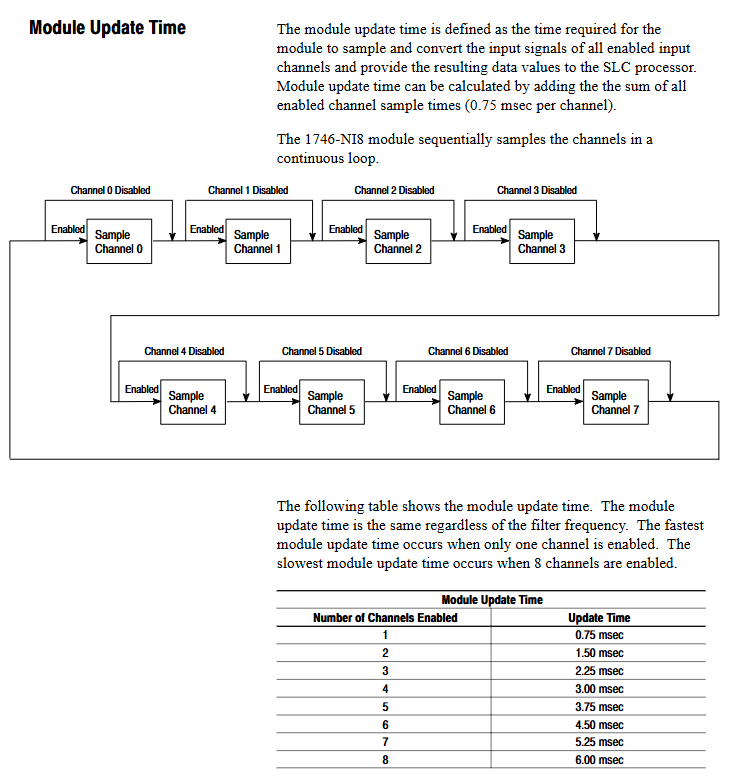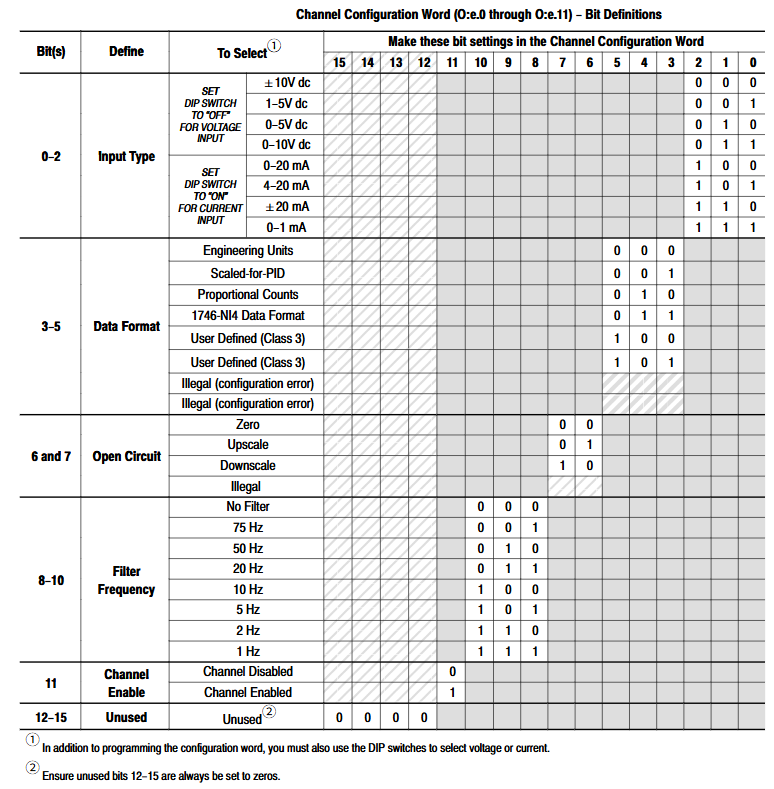Allen Bradley 1746-NI8 SLC 500 Analog Input Module
Supplementary example: Multi parameter monitoring
Requirement: Monitor the three-phase motor current (L1-L3), tank pressure, and liquid level, switch the display through a selection switch, and trigger an alarm for low/high liquid level.
Configuration: Channel 0-2 (4-20mA, current), Channel 3 (4-20mA, pressure), Channel 4 (0-10V DC, liquid level); The ladder program includes scaling, BCD conversion, and alarm logic (trigger light for liquid level<12 inches or>110 inches).

Technical specifications and appendix supplements
Core specifications
Electrical parameters: A/D conversion to successive approximation type, common mode rejection ratio (CMRR) ≥ 75dB at DC and ≥ 100dB at 50/60Hz, channel update time 0.75m/s channel, total module update time 6ms (8-channel enabled).
Physical parameters: Size 56.6 × 12.1 × 77.5mm (2.23 × 0.48 × 3.05 inches), weight 30.9g (1.09 ounces), terminal supports 2 channels of 14 AWG wires.
Appendix Resources
Appendix A: Complete Electrical/Environmental/Physical Specification Table.
Appendix B: Channel Configuration Worksheet (including bit definition and setting examples).
Appendix C: ID code, address, and configuration word adaptation method for migrating from 1746-NI4 (4-channel) to 1746-NI8.
Appendix D: Binary Supplement Explanation (Explaining SLC Processor Data Storage Format).
Key precautions
Compatibility check: The compatibility of module combinations (refer to Table 3-2 in the manual) needs to be confirmed for the 2-slot expansion chassis (1746-A2), and some combinations require external power supply; The programming software needs to support Class 3 mode (such as RSLogix 500 V1.30+).
Anti interference measures: The distance between the analog line and the power line should be ≥ 15cm, shielded twisted pair cables should be used, and the shielding layer should be grounded at one end; Choose an appropriate filtering frequency (such as 10Hz filtering in a 60Hz environment) to reduce power frequency noise.
Safety regulations: Installation/disassembly/wiring must be powered off, hazardous environments (such as Class I Zone 2) must meet explosion-proof requirements, module grounding relies on DIN rails (recommended galvanized steel rails), fixed every 200mm.

- EMERSON
- Honeywell
- CTI
- Rolls-Royce
- General Electric
- Woodward
- Yaskawa
- xYCOM
- Motorola
- Siemens
- Rockwell
- ABB
- B&R
- HIMA
- Construction site
- electricity
- Automobile market
- PLC
- DCS
- Motor drivers
- VSD
- Implications
- cement
- CO2
- CEM
- methane
- Artificial intelligence
- Titanic
- Solar energy
- Hydrogen fuel cell
- Hydrogen and fuel cells
- Hydrogen and oxygen fuel cells
- tyre
- Chemical fiber
- dynamo
- corpuscle
- Pulp and paper
- printing
- fossil
- FANUC
- Food and beverage
- Life science
- Sewage treatment
- Personal care
- electricity
- boats
- infrastructure
- Automobile industry
- metallurgy
- Nuclear power generation
- Geothermal power generation
- Water and wastewater
- Infrastructure construction
- Mine hazard
- steel
- papermaking
- Natural gas industry
- Infrastructure construction
- Power and energy
- Rubber and plastic
- Renewable energy
- pharmacy
- mining
- Plastic industry
- Schneider
- Kongsberg
- NI
- Wind energy
- International petroleum
- International new energy network
- gas
- WATLOW
- ProSoft
- SEW
- wind
- ADVANCED
- Reliance
- YOKOGAWA
- TRICONEX
- FOXBORO
- METSO
- MAN
- Advantest
- ADVANCED
- ALSTOM
- Control Wave
- AB
- AMAT
- STUDER
- KONGSBERG
- MOTOROLA
- DANAHER MOTION
- Bently
- Galil
- EATON
- MOLEX
- Triconex
- DEIF
- B&W
- ZYGO
- Aerotech
- DANFOSS
- KOLLMORGEN
- Beijer
- Endress+Hauser
- MOOG
- KB
- Moxa
- Rexroth
- YAMAHA
- Johnson
- Westinghouse
- WAGO
- TOSHIBA
- TEKTRONIX
- BENDER
- BMCM
- SMC


Email:wang@kongjiangauto.com


































































































































